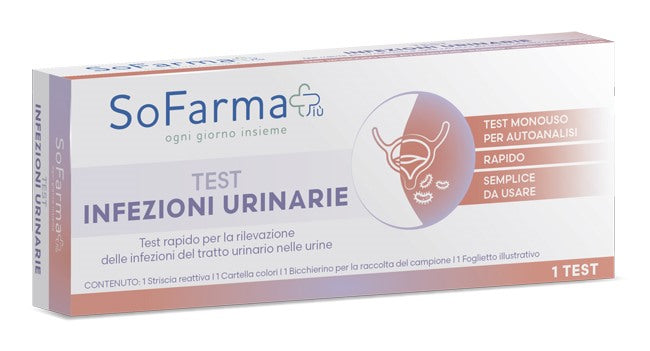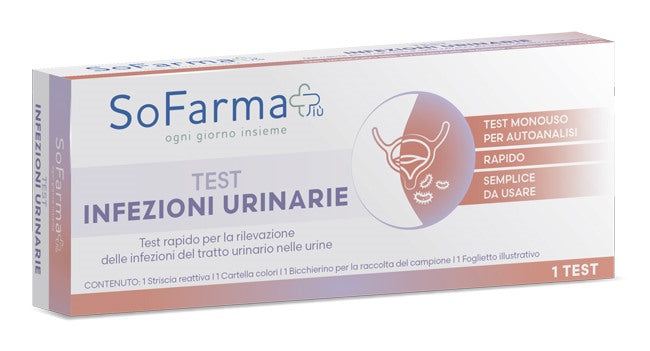Sofarmapiu' Rapid Self-Test Urinary Tract Infections Sofarmapiu'
Sold out
41% off
€5,81
€9,90
Unit price
/
Unavailable
Tax included, shipping and discounts calculated at checkout.
SOFARMAPIU | SKU:
987776731
Notify me when it's back in stock!
Write us your email, you will be notified when this product becomes available again!
Sofarmapiu' Rapid Self-Test Urinary Tract Infections Sofarmapiu' is backordered and will ship as soon as it is back in stock.
Shipping Costs and Times
Shipping Costs and Times
- Order fulfillment within 24 hours and delivery within the following 48/72 hours.
- Shipping cost: always free for orders over €49.90, otherwise it costs €4.99.
Payments
Payments
Payment information is processed securely. We do not store credit card information or have access to your credit card information.
Returns and Refunds
Returns and Refunds
You can return and receive a refund for the item within 30 days. See full policy here.

Do you need help?
Our customer service is here to help you!
- Contact us by phone, email or WhatsApp, from Monday to Friday, from 9:00 to 20:00 .
- For common questions, such as tracking your order or checking its fulfillment status, you can count on our artificial intelligence , available 24/7 .
We are always at your side to offer you fast and effective support!
Description
Description
RAPID SELF-DIAGNOSTIC TEST URINARY INFECTIONS SOFARMAPIU' SOFARMAPIU'
SoFarma
URINARY INFECTION TEST
Description
The urinary tract infection (urine) test consists of hard plastic strips with several separate reagent areas applied to them.
The test is used for the qualitative detection of the following analytes in urine: blood, proteins, nitrites and leukocytes.
For self-analysis.
How to use
It is recommended to collect a urine sample for testing in the early morning as it is the most concentrated. The urine used for testing should not come into contact with toilet water or any disinfectant or cleaning substance.
For women only: The test should not be performed during or for three days after your menstrual cycle. The urine sample should not be contaminated with vaginal fluids as this may produce a misleading result.
Don't make any important medical decisions without first consulting your doctor.
Sample Collection : Collect some of the urine in the plastic cup provided or using a clean cup without any residual detergent. Make sure to fill the cup with urine.
Running the test
Open the foil pouch and remove the test strip. Do not touch the test fields. Once the pouch is opened, it is recommended to perform the test immediately.
Dip the test strip into the urine sample. Press the strip and make sure all four test fields are immersed for about 1-2 seconds. Then remove the test strip and wipe excess urine against the rim of the container or with an absorbent material (such as a paper towel) to avoid mixing chemicals from adjacent test areas.
Wait 2 minutes (do not read the results after 3 minutes). Read the result separately for each parameter, compare the color with the color chart provided.
Reading the results
Read the result separately for each parameter; compare the color with the color chart provided. Color changes at the edges of the test fields or color changes after more than 3 minutes should be ignored.
NEGATIVE: The test field for LEUKOCYTES remained whitish.
The BLOOD test field remained mustard yellow.
The test field for NITRITES remained blank.
The test field for PROTEIN remained yellowish.
POSITIVE FOR LEUKOCYTES: If the color of the test field has changed to purple, leukocytes have been found in the urine. The presence of leukocytes in the urine is an important symptom of inflammation of the kidneys and urinary tract. Taking cephalexin and cephalothin or a high concentration of oxalic acid can also cause the test results to be artificially low. Tetracycline can cause reduced reactivity and high levels of the drug can cause a false negative reaction. High urinary protein content can decrease the intensity of the reaction color.
POSITIVE FOR BLOOD: If the color of the test field has turned green (or some green spots appear in the background), blood has been found in the urine. Uniform green color conversion indicates the presence of hemoglobin or hemolyzed red blood cells; scattered or compact green spots indicate intact red blood cells. Urine occult blood general attributed to the following three reasons, one is stone, inflammation and cancer. In the aspect of inflammation, such as glomerulonephritis, pyelonephritis, cystitis, but may have hematuria, urine occult blood will have occurred. Whether it is kidney, ureter or bladder stones, they can cause other situations such as occult blood. Tumor can also cause occult blood, such as benign or malignant tumor of the kidney, ureter and bladder. Menstrual period, constipation can cause a positive result.
POSITIVE FOR NITRITES: If the color of the test field has changed to pink, then nitrites have been found in the urine. Gram-negative bacteria in the urine convert nitrates from food into nitrites. Nitrites react with a chemical in the test field and leave a pink tinge. The test result may be distorted if the urine does not remain in the bladder for a long time, due to hunger, a plant-free diet, or antibiotic treatment. Comparing the test to a white background can help detect low levels of nitrites, which may otherwise be missed.
POSITIVE FOR PROTEIN: If the color of the test field has turned green, protein has been found in the urine. An indicator on the test field reacts with protein in the urine, changing its color to green. They can be found where there is inflammation of the bladder or prostate or bleeding in the urinary tract. Infusions containing polyvinylpyrrolidone may produce a false positive result. Chemical components in the test fields should be considered potentially hazardous substances, although they do not pose a risk, provided that all test components are used in accordance with these instructions.
Warnings
Read the instructions carefully before performing the test.
For in vitro diagnostic self-testing only.
Use a clean container not contaminated by cleaning fluids to collect the urine.
Keep out of reach of children.
Do not use after expiration date or if pouch is damaged.
If the aluminum package is damaged or has been opened, do not use it.
Strictly follow the indicated time.
Use the test only once. Do not disassemble or touch the reagent areas of the test strip.
For external use only.
The used test must be disposed of according to local regulations.
If you have difficulty identifying color (such as color blindness), ask for help reading the test.
The test may be affected by substances that cause abnormal urine color such as medications containing azo dyes (e.g., Pyridium, AzoGantrisin, AzoGantanol), nitrofurantoin (Microdantin, Furadantin), and riboflavin. The color development on the test pad may be masked or a color reaction may be produced that could be interpreted as false results.
Leukocytes: The result should be read at 2 minutes to allow for full color development. The intensity of the color that develops is proportional to the number of leukocytes present in the urine specimen. High specific gravity or high glucose concentrations (≥2,000 mg/dL) may cause artificially low test results. The presence of cephalexin, cephalothin, or high concentrations of oxalic acid may also cause test results to be artificially low. Tetracycline may cause decreased reactivity and high levels of the drug may cause a false negative reaction. High urinary protein may decrease the intensity of the color reaction. This test will not react with red blood cells or common bacteria in urine.
Blood: A solid green color indicates the presence of myoglobin, hemoglobin, or hemolyzed red blood cells. Scattered or solid green spots indicate intact red blood cells. Separate color scales are provided for hemoglobin and red blood cells to improve accuracy. Positive results with this test are often seen with urine from menstruating females. High urine pH has been reported to reduce sensitivity, while moderate to high concentrations of ascorbic acid may inhibit color formation. Microbial peroxidase, associated with urinary tract infection, may cause a false positive reaction. The test is slightly more sensitive to free hemoglobin and myoglobin than to intact red blood cells.
Nitrite: The test is specific for nitrite and will not react with any other substance normally excreted in urine. Any degree of color from pink to solid red should be interpreted as a positive result, suggesting the presence of nitrite. The intensity of the color is not proportional to the number of bacteria present in the urine specimen. Pink spots or pink edges should not be interpreted as a positive result. Comparison of the area of reacted reagent to a white background may aid in the detection of low levels of nitrite, which may otherwise be missed. Ascorbic acid greater than 30 mg/dL may cause false negative results in urine containing less than 0.05 mg/dL of nitrite ions. The sensitivity of this test is reduced for urine specimens with highly buffered alkaline urine or high specific gravity. A negative result never excludes the possibility of bacteruria. Negative results may occur in urinary tract infections by organisms that do not contain reductase to convert nitrate to nitrite; when urine has not been retained in the bladder for a sufficient period of time (at least 4 hours) for the nitrate to be reduced to nitrite; when receiving antibiotic therapy or when dietary nitrate is absent.
Protein: Any green color indicates the presence of protein in the urine. This test is highly sensitive to albumin and less sensitive to hemoglobin, globulin, and mucoprotein. A negative result does not rule out the presence of these other proteins. False positive results may occur with highly buffered or alkaline urine. Contamination of urine samples with quaternary ammonium compounds or skin cleansers containing chlorhexidine may produce false positive results. Urine samples with a high specific gravity may give false negative results.
Conservation
Store at room temperature or refrigerated (2-30°C). Do not freeze.
Validity with intact packaging: 24 months.
Format
The kit contains:
- test strip;
- glass for sample collection;
- color chart;
- package leaflet.
Bibliography
1. Henry JB, et al. Clinical Diagnosis and Management by Laboratory Methods, 20th Ed. Philadelphia. Saunders. 371-372, 375, 379, 382, 385, 2001. 2. Ma Junlong, Cong Yulong. The Effect of Bacteriuria on Urine Red Blood Cell Determination by Urine Analyzer. Chinese Journal of Medical Examination, 1999, 22(4):205.
3. Shuai Lihua, Jiujiang Medical Journal 2002, 17 (2): 122.
Code SF-017
The urinary tract infection (urine) test consists of hard plastic strips with several separate reagent areas applied to them.
The test is used for the qualitative detection of the following analytes in urine: blood, proteins, nitrites and leukocytes.
For self-analysis.
How to use
It is recommended to collect a urine sample for testing in the early morning as it is the most concentrated. The urine used for testing should not come into contact with toilet water or any disinfectant or cleaning substance.
For women only: The test should not be performed during or for three days after your menstrual cycle. The urine sample should not be contaminated with vaginal fluids as this may produce a misleading result.
Don't make any important medical decisions without first consulting your doctor.
Sample Collection : Collect some of the urine in the plastic cup provided or using a clean cup without any residual detergent. Make sure to fill the cup with urine.
Running the test
Open the foil pouch and remove the test strip. Do not touch the test fields. Once the pouch is opened, it is recommended to perform the test immediately.
Dip the test strip into the urine sample. Press the strip and make sure all four test fields are immersed for about 1-2 seconds. Then remove the test strip and wipe excess urine against the rim of the container or with an absorbent material (such as a paper towel) to avoid mixing chemicals from adjacent test areas.
Wait 2 minutes (do not read the results after 3 minutes). Read the result separately for each parameter, compare the color with the color chart provided.
Reading the results
Read the result separately for each parameter; compare the color with the color chart provided. Color changes at the edges of the test fields or color changes after more than 3 minutes should be ignored.
NEGATIVE: The test field for LEUKOCYTES remained whitish.
The BLOOD test field remained mustard yellow.
The test field for NITRITES remained blank.
The test field for PROTEIN remained yellowish.
POSITIVE FOR LEUKOCYTES: If the color of the test field has changed to purple, leukocytes have been found in the urine. The presence of leukocytes in the urine is an important symptom of inflammation of the kidneys and urinary tract. Taking cephalexin and cephalothin or a high concentration of oxalic acid can also cause the test results to be artificially low. Tetracycline can cause reduced reactivity and high levels of the drug can cause a false negative reaction. High urinary protein content can decrease the intensity of the reaction color.
POSITIVE FOR BLOOD: If the color of the test field has turned green (or some green spots appear in the background), blood has been found in the urine. Uniform green color conversion indicates the presence of hemoglobin or hemolyzed red blood cells; scattered or compact green spots indicate intact red blood cells. Urine occult blood general attributed to the following three reasons, one is stone, inflammation and cancer. In the aspect of inflammation, such as glomerulonephritis, pyelonephritis, cystitis, but may have hematuria, urine occult blood will have occurred. Whether it is kidney, ureter or bladder stones, they can cause other situations such as occult blood. Tumor can also cause occult blood, such as benign or malignant tumor of the kidney, ureter and bladder. Menstrual period, constipation can cause a positive result.
POSITIVE FOR NITRITES: If the color of the test field has changed to pink, then nitrites have been found in the urine. Gram-negative bacteria in the urine convert nitrates from food into nitrites. Nitrites react with a chemical in the test field and leave a pink tinge. The test result may be distorted if the urine does not remain in the bladder for a long time, due to hunger, a plant-free diet, or antibiotic treatment. Comparing the test to a white background can help detect low levels of nitrites, which may otherwise be missed.
POSITIVE FOR PROTEIN: If the color of the test field has turned green, protein has been found in the urine. An indicator on the test field reacts with protein in the urine, changing its color to green. They can be found where there is inflammation of the bladder or prostate or bleeding in the urinary tract. Infusions containing polyvinylpyrrolidone may produce a false positive result. Chemical components in the test fields should be considered potentially hazardous substances, although they do not pose a risk, provided that all test components are used in accordance with these instructions.
Warnings
Read the instructions carefully before performing the test.
For in vitro diagnostic self-testing only.
Use a clean container not contaminated by cleaning fluids to collect the urine.
Keep out of reach of children.
Do not use after expiration date or if pouch is damaged.
If the aluminum package is damaged or has been opened, do not use it.
Strictly follow the indicated time.
Use the test only once. Do not disassemble or touch the reagent areas of the test strip.
For external use only.
The used test must be disposed of according to local regulations.
If you have difficulty identifying color (such as color blindness), ask for help reading the test.
The test may be affected by substances that cause abnormal urine color such as medications containing azo dyes (e.g., Pyridium, AzoGantrisin, AzoGantanol), nitrofurantoin (Microdantin, Furadantin), and riboflavin. The color development on the test pad may be masked or a color reaction may be produced that could be interpreted as false results.
Leukocytes: The result should be read at 2 minutes to allow for full color development. The intensity of the color that develops is proportional to the number of leukocytes present in the urine specimen. High specific gravity or high glucose concentrations (≥2,000 mg/dL) may cause artificially low test results. The presence of cephalexin, cephalothin, or high concentrations of oxalic acid may also cause test results to be artificially low. Tetracycline may cause decreased reactivity and high levels of the drug may cause a false negative reaction. High urinary protein may decrease the intensity of the color reaction. This test will not react with red blood cells or common bacteria in urine.
Blood: A solid green color indicates the presence of myoglobin, hemoglobin, or hemolyzed red blood cells. Scattered or solid green spots indicate intact red blood cells. Separate color scales are provided for hemoglobin and red blood cells to improve accuracy. Positive results with this test are often seen with urine from menstruating females. High urine pH has been reported to reduce sensitivity, while moderate to high concentrations of ascorbic acid may inhibit color formation. Microbial peroxidase, associated with urinary tract infection, may cause a false positive reaction. The test is slightly more sensitive to free hemoglobin and myoglobin than to intact red blood cells.
Nitrite: The test is specific for nitrite and will not react with any other substance normally excreted in urine. Any degree of color from pink to solid red should be interpreted as a positive result, suggesting the presence of nitrite. The intensity of the color is not proportional to the number of bacteria present in the urine specimen. Pink spots or pink edges should not be interpreted as a positive result. Comparison of the area of reacted reagent to a white background may aid in the detection of low levels of nitrite, which may otherwise be missed. Ascorbic acid greater than 30 mg/dL may cause false negative results in urine containing less than 0.05 mg/dL of nitrite ions. The sensitivity of this test is reduced for urine specimens with highly buffered alkaline urine or high specific gravity. A negative result never excludes the possibility of bacteruria. Negative results may occur in urinary tract infections by organisms that do not contain reductase to convert nitrate to nitrite; when urine has not been retained in the bladder for a sufficient period of time (at least 4 hours) for the nitrate to be reduced to nitrite; when receiving antibiotic therapy or when dietary nitrate is absent.
Protein: Any green color indicates the presence of protein in the urine. This test is highly sensitive to albumin and less sensitive to hemoglobin, globulin, and mucoprotein. A negative result does not rule out the presence of these other proteins. False positive results may occur with highly buffered or alkaline urine. Contamination of urine samples with quaternary ammonium compounds or skin cleansers containing chlorhexidine may produce false positive results. Urine samples with a high specific gravity may give false negative results.
Conservation
Store at room temperature or refrigerated (2-30°C). Do not freeze.
Validity with intact packaging: 24 months.
Format
The kit contains:
- test strip;
- glass for sample collection;
- color chart;
- package leaflet.
Bibliography
1. Henry JB, et al. Clinical Diagnosis and Management by Laboratory Methods, 20th Ed. Philadelphia. Saunders. 371-372, 375, 379, 382, 385, 2001. 2. Ma Junlong, Cong Yulong. The Effect of Bacteriuria on Urine Red Blood Cell Determination by Urine Analyzer. Chinese Journal of Medical Examination, 1999, 22(4):205.
3. Shuai Lihua, Jiujiang Medical Journal 2002, 17 (2): 122.
Code SF-017


